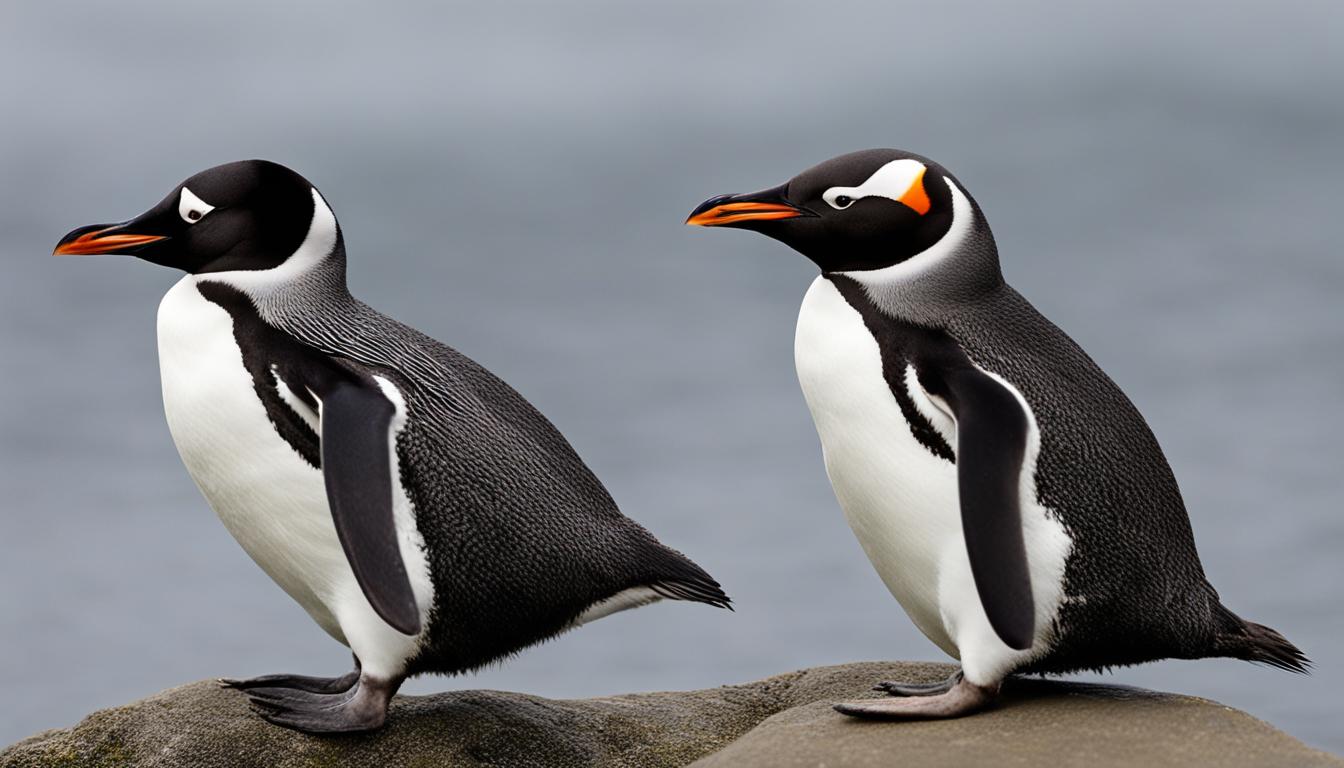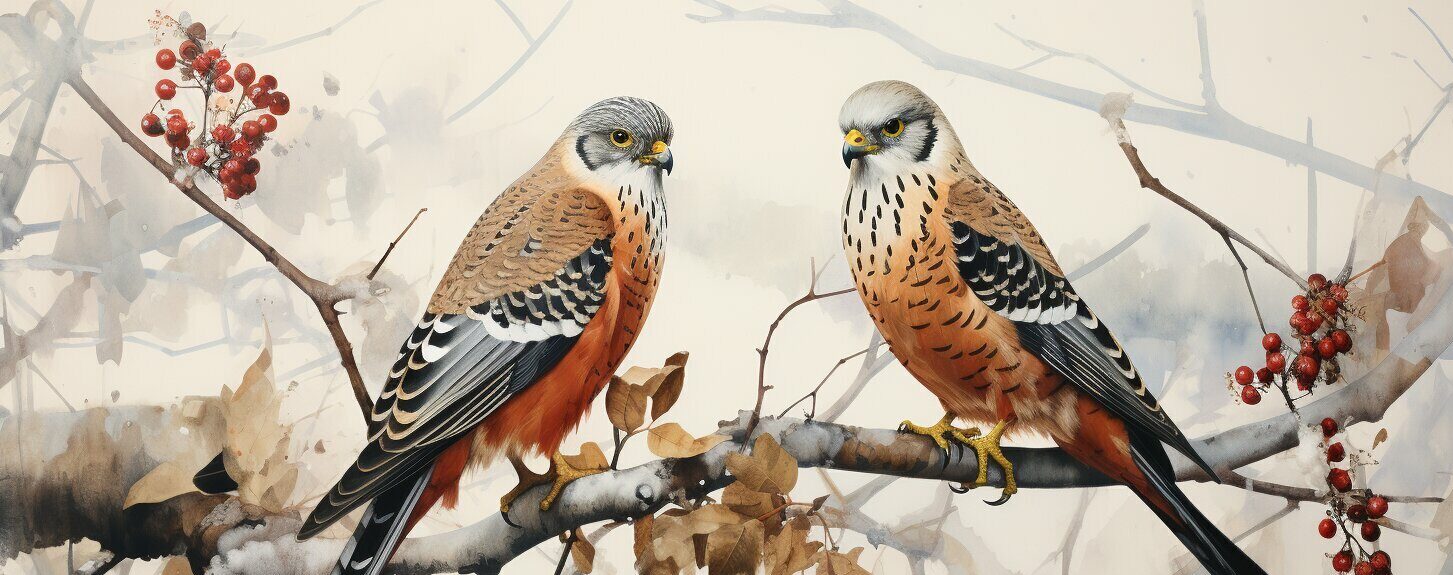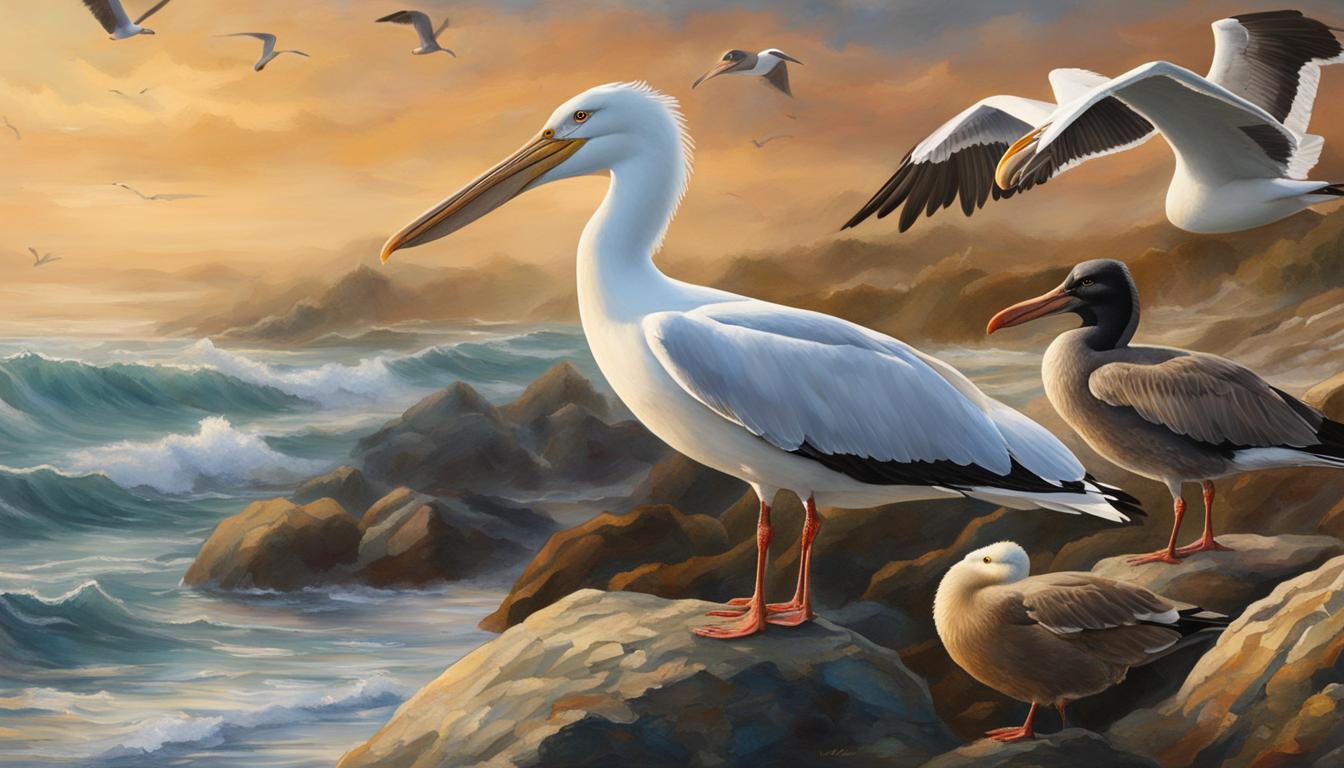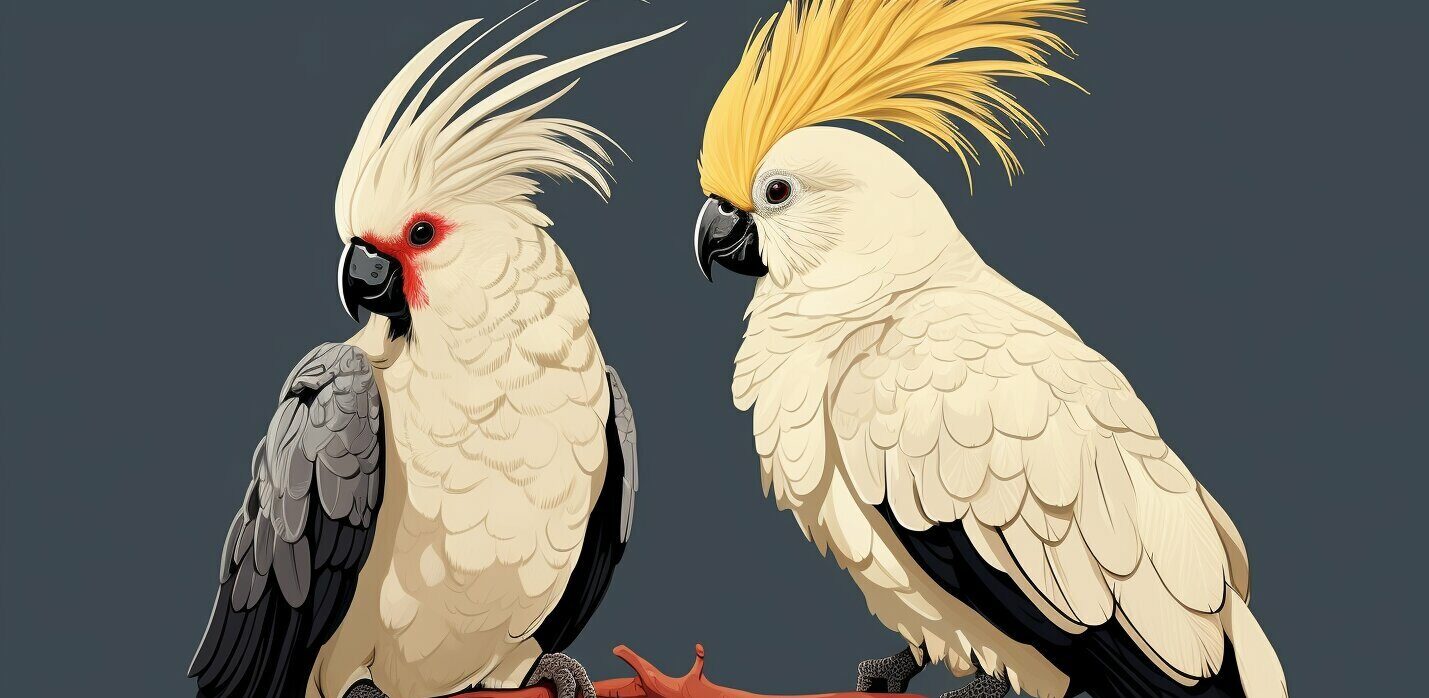Penguins and auklets are both seabirds, but they belong to different families and have distinct characteristics. Penguins are found in the Southern Hemisphere, with 18 species living in various locations such as Antarctica, South Africa, and New Zealand. Auklets, on the other hand, are found in the Northern Hemisphere and belong to the Alcidae family, which also includes murres, guillemots, and puffins. Penguins are flightless, while auklets can fly and swim using their wings. They have different diets, habitats, and behaviors, making them unique in their own ways.
Key Takeaways:
- Penguins and auklets are seabirds with distinct characteristics.
- Penguins are found in the Southern Hemisphere, while auklets are found in the Northern Hemisphere.
- Penguins are flightless, while auklets can fly and swim.
- Penguins have different diets, habitats, and behaviors compared to auklets.
- Understanding the differences between penguins and auklets contributes to a better appreciation of avian diversity.
Physical Characteristics
Penguins and auklets possess distinct physical characteristics that set them apart. While both exhibit the classic black and white coloration and an upright posture, there are notable differences in size and wing structure.
Penguins are generally larger birds compared to auklets. The emperor penguin, for instance, is the largest species, reaching an impressive height of up to 130 cm. On the other hand, auklets are relatively smaller, with the little auklet measuring about 34-42 cm. This significant difference in size contributes to their varying abilities and behaviors in their respective environments.
Another key difference lies in their wing structure. Penguins have wings that are specially adapted for swimming, enabling them to navigate through the water with ease. In contrast, auklets possess wings that are suitable for both flying and swimming, allowing them greater flexibility in their movements both in the air and underwater.
“Penguins and auklets possess distinct physical characteristics that set them apart.”
Comparison of Physical Characteristics
| Penguins | Auklets |
|---|---|
| Larger in size | Relatively smaller |
| Flightless | Wings suitable for flying and swimming |
| Wings adapted for swimming | Wings adapted for both flying and swimming |
This table summarizes the key differences in the physical characteristics of penguins and auklets. Penguins are larger, flightless birds with wings designed specifically for swimming. In contrast, auklets are smaller birds with wings suitable for both flying and swimming.
Understanding these physical characteristics provides valuable insights into the unique adaptations and behaviors of penguins and auklets in their respective habitats.
Penguin Species versus Auklet Species: Understanding the Distinctions
When it comes to penguins and auklets, their habitats and distributions set them apart. Penguins primarily inhabit the Southern Hemisphere, with species like the emperor penguin and king penguin calling Antarctica their home. They can also be found in South America and New Zealand. On the other hand, auklets are predominantly found in the Northern Hemisphere, ranging from the Arctic to the western Mediterranean and the North Atlantic. These birds nest on cliffs or rocky shores and may exhibit migratory behavior, traveling along coasts during certain seasons.
Table: Distribution of Penguin and Auklet Species
| Penguin Species | Distribution |
|---|---|
| Emperor Penguin | Antarctica |
| King Penguin | Subantarctic islands, South Georgia, Falkland Islands |
| Adelie Penguin | Antarctic coast, South Shetland Islands |
| Magellanic Penguin | Argentina, Chile |
Table: Distribution of Auklet Species
| Auklet Species | Distribution |
|---|---|
| Crested Auklet | Northern Pacific, Bering Sea, Aleutian Islands |
| Rhinoceros Auklet | North Pacific, California to Alaska |
| Least Auklet | North Pacific, Bering Sea, Alaska Peninsula |
These distinct habitats and distribution patterns contribute to the different ecological roles and adaptations of penguins and auklets. While penguins thrive in the extreme cold of the Southern Hemisphere, auklets have adapted to the colder waters of the Northern Hemisphere. Understanding these distinctions helps us appreciate the diverse environments in which these birds live and the unique challenges they face.
Penguin and Auklet Behaviors and Feeding Habits
Penguins and auklets exhibit distinct behaviors and feeding habits that are shaped by their unique adaptations and ecological roles. Penguins are highly social birds, often found in large colonies. They display a range of social behaviors, including courtship rituals, vocalizations, and synchronized movements. Their gregarious nature helps them defend their territories and share vital information about food sources and potential threats.
Auklets also exhibit gregarious behavior, living in colonies and nesting in cliffside burrows. They engage in courtship displays and vocalize to establish and maintain pair bonds. Like penguins, auklets rely on social cues to navigate their environments and find food. The presence of large colonies provides them with protection and increases their chances of successful reproduction.
“The social behavior of penguins and auklets is fascinating to observe. The synchronized movements and vocalizations displayed by these birds highlight their strong social bonds and cooperative nature.”
Regarding feeding habits, penguins and auklets primarily consume marine organisms. Penguins are skilled swimmers, using their wings to propel themselves underwater. They mainly feed on small fish, crustaceans, and marine worms, which they catch using their sharp beaks. Their streamlined bodies and strong diving abilities enable them to hunt efficiently and navigate underwater obstacles.
Auklets are also adept swimmers and feed on similar prey items. Their wing structure allows them to fly and swim, giving them more flexibility and variety in their foraging strategies. They dive underwater to catch small fish and invertebrates, using their sharp bills to capture their prey. Auklets are known for their agility in the water, swiftly maneuvering to catch fast-moving prey.
| Penguin Behaviors | Auklet Behaviors |
|---|---|
| – Highly social – Courtship rituals and vocalizations – Synchronized movements – Strong social bonds – Cooperative behavior |
– Highly social – Courtship displays and vocalizations – Nesting in colonies – Strong social bonds – Cooperative behavior |
In summary, penguins and auklets exhibit unique behaviors and feeding habits that reflect their adaptations and ecological niches. While penguins rely on their strong swimming abilities and exhibit complex social behaviors in their predominantly southern habitats, auklets utilize their flying and swimming capabilities in their northern environments. Understanding these behaviors and feeding habits enhances our appreciation for the diverse avian world and the fascinating adaptations that allow these birds to thrive.
Penguins and Auklets Conservation Challenges and Threats
In recent years, both penguins and auklets have faced significant conservation challenges due to a range of threats. These threats include climate change, habitat loss, pollution, and disturbances from human activities. The conservation efforts for these bird species have become crucial to ensure their long-term survival and the health of their ecosystems.
The International Union for Conservation of Nature (IUCN) has classified some penguin species, such as the emperor penguin, as Near Threatened. Climate change has a severe impact on penguins, as rising temperatures and melting ice have a direct effect on their habitat and food sources. Penguins rely on sea ice for breeding and hunting, and any disruption to this delicate balance can have detrimental effects on their populations.
Climate change, habitat loss, pollution, and disturbance from human activities are major concerns for penguins and auklets.
Auklets also face similar threats, including disturbances to their nesting colonies and changes in oceanic conditions. The disturbance to their nesting colonies can result from human activities such as tourism, urbanization, and fisheries. Changes in oceanic conditions, such as warming temperatures and changes in prey availability, can disrupt their feeding patterns and put additional stress on their populations.
Conservation efforts for both penguins and auklets involve implementing measures to mitigate the impact of these threats, protecting their habitats, and raising awareness about the importance of these bird species in their respective ecosystems. Collaborative efforts between governments, conservation organizations, and local communities are crucial to ensure the effective conservation of these magnificent seabirds and the preservation of their unique habitats.
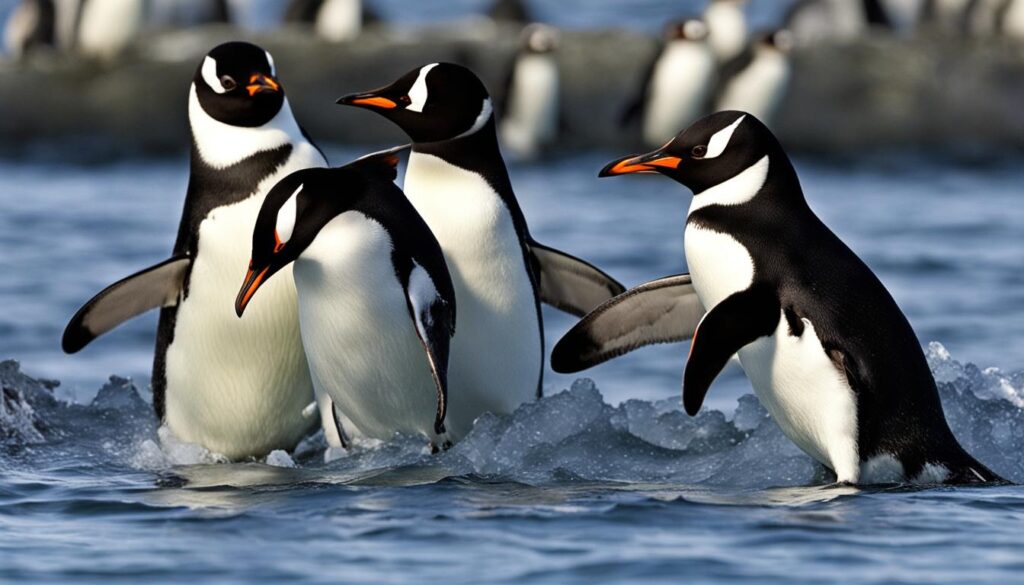
Adaptations to Life in the Cold Seas
Penguins and auklets have evolved remarkable adaptations that allow them to survive and thrive in the cold seas. One of their key adaptations is their feathers, which provide insulation and waterproofing. Penguins have dense and oily feathers that help them stay warm and buoyant in the water, while auklets have similar waterproof feathers that may not have the same level of density as penguins. This is crucial for both species as they spend a significant amount of time in the frigid waters of their respective habitats.
In addition to their feathers, penguins have developed a counter-current heat exchange system. This system allows them to conserve body heat by reducing heat loss through their extremities. It works by transferring heat from the warm arteries to the cold veins, ensuring that the warm blood returning to the body core is not cooled down by the cold blood coming from the extremities. This adaptation allows penguins to maintain their body temperature even in extreme cold conditions, making them well-suited for their Antarctic environment.
Another adaptation that penguins have is a high metabolic rate. This means that they can generate and maintain heat internally, which is crucial for their survival in cold waters. The high metabolic rate enables them to convert food into energy quickly, providing them with the necessary stamina for swimming, diving, and hunting in the icy seas. This adaptation also helps them cope with the harsh conditions during breeding seasons when they need extra energy to incubate their eggs and care for their young.
Comparative Adaptations
| Penguins | Auklets |
|---|---|
| Have dense and oily feathers for insulation and buoyancy | Have waterproof feathers, though possibly less dense than penguins’ |
| Utilize a counter-current heat exchange system to conserve body heat | No known equivalent adaptation |
| Have a high metabolic rate to generate and maintain internal heat | No known equivalent adaptation |
These adaptations allow penguins and auklets to inhabit the cold seas successfully. While penguins have a more diverse range of adaptations, auklets have evolved strategies that suit their flying and swimming abilities. Understanding these remarkable adaptations provides insights into the unique ways in which different bird species have adapted to survive and thrive in challenging environments.
Cultural Significance
Penguins and auklets hold significant cultural value and have become prominent symbols in various forms of media and artistic representations. Their unique characteristics and behaviors have captivated the imagination of people around the world.
For penguins, their charming and distinctive appearance has made them popular figures in movies, literature, and advertising. They often symbolize traits like resilience, teamwork, and determination. Movies like Happy Feet and March of the Penguins have showcased the endearing nature of these birds, further solidifying their cultural significance. The image of penguins waddling together in a group has become iconic and is often used as a representation of unity and cooperation.
Penguins are beloved by many for their adorable appearance and captivating behaviors, serving as a reminder of the beauty and marvels of the natural world.
Auklets, although less well-known, have also made appearances in cultural references, particularly in regions where they are found. Their distinctive appearance, with tufted feathers and unique colors, has made them subjects of artistic and educational interest. Auklets are often portrayed in paintings, sculptures, and photographs, highlighting their natural beauty and intriguing characteristics.
Both penguins and auklets have become symbols of the wonders of the avian world, inspiring awe and admiration in people of all ages. Their cultural significance serves as a testament to the fascination and respect that these remarkable birds evoke.
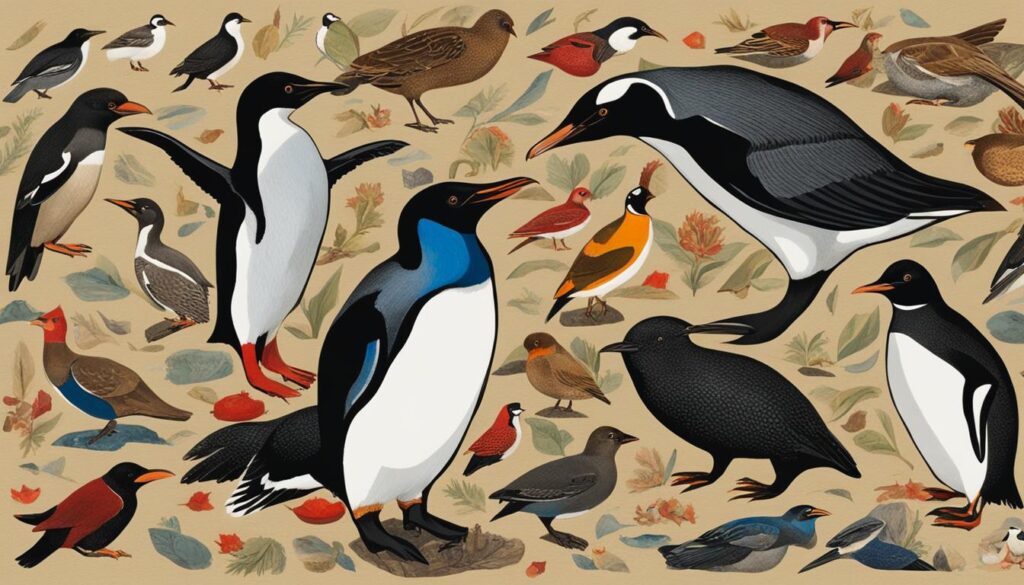
Table: Cultural Representations of Penguins and Auklets
| Cultural Representations | Penguins | Auklets |
|---|---|---|
| Movies | Happy Feet, March of the Penguins | N/A |
| Literature | Mr. Popper’s Penguins | N/A |
| Advertising | Various brands and campaigns | N/A |
| Artistic representations | Penguins depicted in paintings, sculptures, and photography | Auklets depicted in paintings and sculptures |
| Symbolism | Resilience, teamwork, and determination | Natural beauty and intriguing characteristics |
Conclusion
In conclusion, exploring the contrast between penguins and auklets reveals their unique characteristics, habitats, and behaviors. While both birds share some physical similarities, such as their black and white coloration and upright posture, they belong to different families and have distinct adaptations. Penguins are flightless and primarily inhabit the Southern Hemisphere, while auklets can fly and are found in the Northern Hemisphere. These differences in flight capabilities and geographic distribution contribute to their diverse ecological roles and behaviors.
Furthermore, penguins and auklets have different feeding habits and conservation statuses. Penguins are known for their social behavior and rely on their wings for swimming to catch prey, while auklets exhibit gregarious behavior and have the additional ability to fly, providing them with more foraging flexibility. Both species face conservation challenges due to threats such as climate change, habitat loss, and human disturbance. Protecting these birds and their habitats is crucial for their continued survival and the health of the ecosystems they inhabit.
In summary, understanding the contrast between penguins and auklets enhances our appreciation for the diversity and complexity of the avian world. From their distinct physical characteristics and habitats to their behaviors and adaptations, these seabirds have evolved in unique ways to thrive in their respective environments. Exploring the contrast between penguins and auklets allows us to delve deeper into the fascinating world of these remarkable birds and the intricate web of life they are a part of.
FAQ
What is the difference between penguins and auklets?
Penguins and auklets are both seabirds but belong to different families and have distinct characteristics, habitats, and behaviors.
Where are penguins found?
Penguins are mainly found in the Southern Hemisphere, with species inhabiting Antarctica, South America, and New Zealand.
Where are auklets found?
Auklets are found in the Northern Hemisphere, ranging from the Arctic to the western Mediterranean and the North Atlantic.
Can penguins fly?
No, penguins are flightless birds.
Can auklets fly?
Yes, auklets can fly and swim using their wings.
What do penguins eat?
Penguins mainly feed on small fish, crustaceans, and marine worms.
What do auklets eat?
Auklets also feed on small fish, crustaceans, and marine worms.
How do penguins and auklets adapt to the cold seas?
Both penguins and auklets have unique feathers that provide insulation and waterproofing. Penguins have dense and oily feathers, while auklets have similar waterproof feathers but may not have the same level of density.
Are penguins and auklets endangered?
Some penguin species, such as the emperor penguin, are classified as Near Threatened. Auklets also face conservation concerns due to habitat disturbance and changes in oceanic conditions.
What is the cultural significance of penguins and auklets?
Penguins and auklets hold cultural significance in different parts of the world, often representing resilience, teamwork, and determination. They are beloved and iconic figures in movies, literature, and advertising.
 Skip to main content
Skip to main content